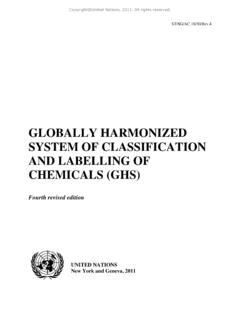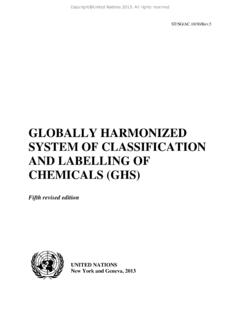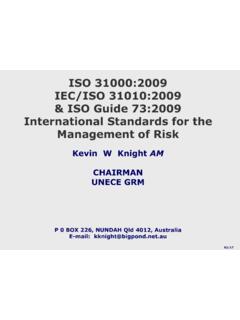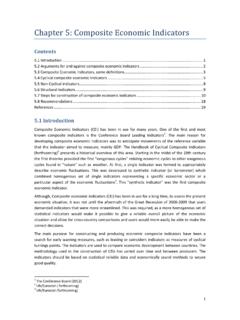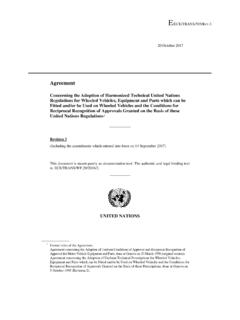Transcription of Recommendations on the TRANSPORT OF DANGEROUS …
1 UNITED NATIONS New York and Geneva, 2015 ST/ Recommendations on the TRANSPORT OF DANGEROUS GOODS Manual of Tests and Criteria Sixth revised edition Copyright United Nations, 2015. All rights reservedNOTE The designations employed and the presentation of the material in this publication do not imply the expression of any opinion whatsoever on the part of the Secretariat of the United Nations concerning the legal status of any country, territory, city or area, or of its authorities, or concerning the delimitation of its frontiers or boundaries. ST/ Copyright United Nations, 2015 All rights reserved. No part of this publication may, for sales purposes, be reproduced, stored in a retrieval system or transmitted in any form or by any means, electronic, electrostatic, magnetic tape, mechanical, photocopying or otherwise, without prior permission in writing from the United Nations.
2 UNITED NATIONS PUBLICATION Sales No.: ISBN 978-92-1-139155-8 eISBN 978-92-1-057567-6 ISSN 1014-7160 Copyright United Nations, 2015. All rights reserved- iii - FOREWORD The " Recommendations on the TRANSPORT of DANGEROUS Goods, Manual of Tests and Criteria" supplement the " Recommendations on the TRANSPORT of DANGEROUS Goods, Model Regulations" and the "Globally Harmonized System of classification and labelling of Chemicals (GHS)". They contain criteria, test methods and procedures to be used for the classification of DANGEROUS goods according to the provisions of Parts 2 and 3 of the Model Regulations, as well as of chemicals presenting physical hazards according to the GHS. Originally developed by the Economic and Social Council s Committee of Experts on the TRANSPORT of DANGEROUS Goods, which adopted a first version in 1984, the Manual of Tests and Criteria has been regularly updated and amended.
3 Presently, the updating is done under the auspices of the Committee of Experts on the TRANSPORT of DANGEROUS Goods and on the Globally Harmonized System of classification and labelling of Chemicals, which replaced the original committee in 2001. This sixth revised edition includes all the amendments to the fifth revised edition adopted by the Committee at its fifth and sixth sessions in 2010 and 2012 (published under the symbols ST/ and ST/ ) and those adopted at its seventh session in 2014 (ST/ ). The new amendments adopted in 2014 address in particular: A new test to measure the sensitiveness of the substance to drop-mass impact and to determine if the substance is too DANGEROUS to TRANSPORT in the form tested (Section 13, Test 3 (a) (vii): Modified Bureau of Mines impact machine test); Updated procedures for the classification of lithium metal and lithium ion cells and batteries (sub-section ); A new test procedure for the classification of substances of Class 9 which may evolve flammable vapours (sub-section ); A new Part V containing schemes for the classification of desensitized explosives for supply and use (including storage) according to the GHS.
4 A new test for the classification of cartridges, small arms (UN No. 0012) (Appendix 9); and Updating of miscellaneous existing provisions. Copyright United Nations, 2015. All rights reservedCopyright United Nations, 2015. All rights reserved- v - GENERAL TABLE OF CONTENTS SectionPage1. GENERAL INTRODUCTION (Introduction, Layout, Precedence of hazard characteristics, Safety, General conditions for testing, Recommended tests and Reporting) .. 1 PART I: classification PROCEDURES, TEST METHODS AND CRITERIA RELATING TO EXPLOSIVES OF CLASS 110. INTRODUCTION TO PART I (Purpose, Scope, Acceptance procedure, Assignment procedure, Examples of test reports) .. 13 11. TEST SERIES 1 (To determine if a substance has explosive properties) .. 33 12. TEST SERIES 2 (To determine if a substance is too insensitive for inclusion in Class 1).
5 53 13. TEST SERIES 3 (To determine if a substance is thermally stable and not too DANGEROUS for TRANSPORT in the form in which it was tested) .. 73 14. TEST SERIES 4 (To determine if an article, packaged article or packaged substance is too DANGEROUS for TRANSPORT ) .. 13715. TEST SERIES 5 (To determine if a substance may be assigned to Division ) .. 143 16. TEST SERIES 6 (To assign a substance or article to Division , , or or exclude it from Class 1) .. 157 17. TEST SERIES 7 (To determine if an article may be assigned to Division ) .. 171 18. TEST SERIES 8 (To determine if an ammonium nitrate emulsion, suspension or gel, intermediate for blasting explosives (ANE), is insensitive enough for inclusion in Division , and to evaluate the suitability for TRANSPORT in tanks).
6 193 PART II: classification PROCEDURES, TEST METHODS AND CRITERIA RELATING TO SELF-REACTIVE SUBSTANCES OF DIVISION AND ORGANIC PEROXIDES OF DIVISION INTRODUCTION TO PART II (Purpose, Scope, Preliminary procedure, classification procedures, Example of test report) .. 22121. TEST SERIES A (To determine if there is propagation of detonation) .. 233 22. TEST SERIES B (To determine if there is detonation in the package) .. 249 23. TEST SERIES C (To determine if there is propagation of deflagration) .. 253 24. TEST SERIES D (To determine if there is rapid deflagration in the package).. 265 25. TEST SERIES E (To determine the effect of heating under confinement).. 269 26. TEST SERIES F (To determine the explosive power) .. 285 27. TEST SERIES G (To determine if there is thermal explosion in the package).
7 309 28. TEST SERIES H (To determine the self-accelerating decomposition temperature) .. 313 Copyright United Nations, 2015. All rights reserved- vi - GENERAL TABLE OF CONTENTS (continued)Section PagePART III: classification PROCEDURES, TEST METHODS AND CRITERIA RELATING TO CLASS 2, CLASS 3, CLASS 4, DIVISION , CLASS 8 AND CLASS 9 30. INTRODUCTION TO PART III (Purpose, Scope) .. 341 PROCEDURES, TEST METHODS AND CRITERIA RELATING TO FLAMMABLE AEROSOLS OF CLASS 2 .. 343 32. classification PROCEDURES, TEST METHODS AND CRITERIA RELATING TO LIQUID DESENSITIZED EXPLOSIVES AND FLAMMABLE LIQUIDS OF CLASS 3 .. 359 33. classification PROCEDURES, TEST METHODS AND CRITERIA RELATING TO CLASS 4 .. 369 34. classification PROCEDURES, TEST METHODS AND CRITERIA RELATING TO OXIDIZING SUBSTANCES OF DIVISION.
8 385 35. DETERMINATION OF chemical INSTABILITY OF GASES AND GAS MIXTURES .. 40536. Reserved for classification procedures, test methods and criteria relating to Class 7 .. PROCEDURES, TEST METHODS AND CRITERIA RELATING TO SUBSTANCES OF CLASS 8 .. 415 38. classification PROCEDURES, TEST METHODS AND CRITERIA RELATING TO CLASS 9 .. 419 PART IV: TEST METHODS CONCERNING TRANSPORT EQUIPMENT 40. INTRODUCTION TO PART IV (Purpose, Scope) .. 441 41. DYNAMIC LONGITUDINAL IMPACT TEST FOR PORTABLE TANKS AND MULTIPLE-ELEMENT GAS CONTAINERS (MEGCs) .. 443 PART V: classification PROCEDURES, TEST METHODS AND CRITERIA RELATING TO SECTORS OTHER THAN TRANSPORT 50 INTRODUCTION TO PART V (Purpose, Scope) .. 453 51 classification PROCEDURES, TEST METHODS AND CRITERIA RELATING TO THE HAZARD CLASS DESENSITIZED EXPLOSIVES.
9 455 APPENDICES .. 463 Appendix 1 SPECIFICATIONS OF STANDARD DETONATORS .. 467 Appendix 2 BRUCETON AND SAMPLE COMPARISON METHODS .. 471 Appendix 3 CAVITATION OF SAMPLES .. 475 Appendix 4 NATIONAL CONTACTS FOR TEST DETAILS .. 479 Copyright United Nations, 2015. All rights reserved- vii - GENERAL TABLE OF CONTENTS (continued)Section PageAppendix 5 EXAMPLE OF A TEST METHOD FOR VENT SIZING .. 481 Appendix 6 SCREENING PROCEDURES .. 487 Appendix 7 HSL FLASH COMPOSITION TEST .. 493 Appendix 8 RESPONSE DESCRIPTORS .. 501 Appendix 9 BALLISTIC PROJECTION ENERGY TEST FOR CARTRIDGES, SMALL ARMS (UN NO. 0012) .. 504 Copyright United Nations, 2015. All rights reservedCopyright United Nations, 2015. All rights reserved- 1 - SECTION 1 GENERAL INTRODUCTIONNOTE:This general introduction relates only to Parts I to III of the Manual of Tests and Criteria and its Appendices 1 to 9.
10 At its second session (10 December 2004), the Committee of Experts on the TRANSPORT of DANGEROUS Goods and on the Globally Harmonized System of classification and labelling of Chemicals decided to add a new Part IV relating to tests methods concerning TRANSPORT equipment. At its seventh session, the Committee of Experts on the TRANSPORT of DANGEROUS Goods and the Globally Harmonized System of classification and labelling of Chemicals decided to add a new Part V relating to classification procedures, test methods and criteria relating to sectors other than TRANSPORT . Introduction The purpose of this text is to present the United Nations schemes for the classification of certain types of DANGEROUS goods and to give descriptions of the test methods and procedures considered to be the most useful for providing competent authorities with the necessary information to arrive at a proper classification of substances and articles for TRANSPORT .
